It looks like you're using an Ad Blocker.
Please white-list or disable AboveTopSecret.com in your ad-blocking tool.
Thank you.
Some features of ATS will be disabled while you continue to use an ad-blocker.
share:
I recently came across the Indus Valley seal seen below which allows one to make all sorts of very intriguing connections as in my opinion this is
quite unique in showing the production of Soma in that culture, and there are direct correlations between this iconography and that of early
Mesopotamian Jemdet Nasr period seals which show the cultivation and extraction of Opium to produce a sacred drink that i looked at in
Anunnaki and the Cultivation of Opium

I shall explain why, but it became apparent through reading the 114 Soma Pavamana Hymns of the Rig-Veda which i shall quote from that the connection to the seven sages as founders of civilization and sacred writing with Soma was a very direct one, that the Rishi families which had directed this controlled the cultivation of Opium, that in the Mesopotamian tradition this had been the basis for other worldly contact.

It can be seen in the above text and seal that the Bull of Heaven, Taurus, was the direct translation of the power of Soma into the Heavens, it's body the Pavamana, this was understood as directed through a stream of Soma which the seated figure can be seen to release from a jar, perhaps also in the form of fishes, which would explain why streams and fishes are often seen in conjunction with the bull in Indus valley representation and Elamite, but also one notes behind the figure a walking bird on a low table or seat, as is the case in the first seal too, and that association directly relates to the tradition of the seated woman on Jemdet Nasr seals, as it is Ka-ka the bird beneath the Orion constellation, a bird that rode high in joy, were the Sumerian term for the Opium plant was Hul-Gil, plant of joy, see also The Sumerian Orion Tradition and The Oldest representation of Orion
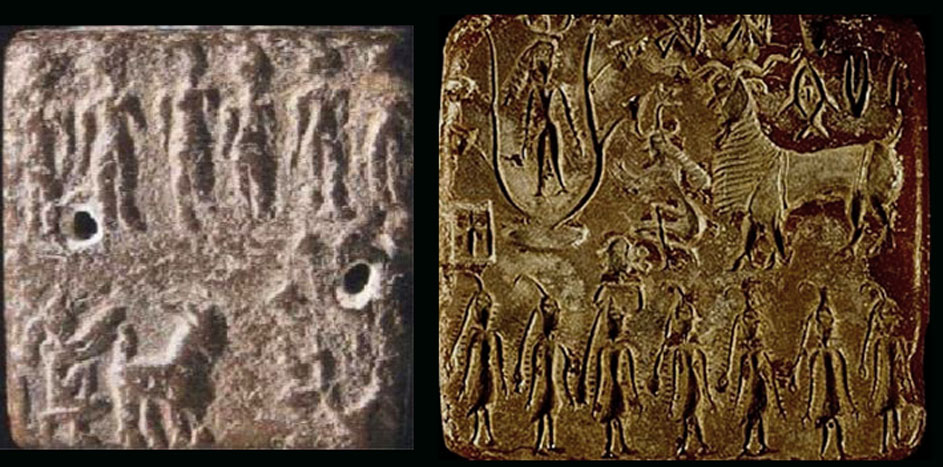
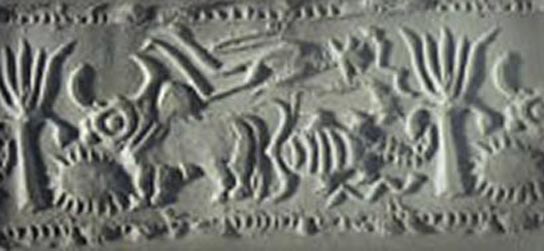
Again the plaque above it can be seen that the seated woman with pony tail has replaced that of the horned male figure in the previous example, that the two are closely connected, the one in the production of Soma and likely the Male figure in it's translation into the bull of Heaven, in connection with the double fig tree representing Gemini as the gateway into the after-life.
The numerology involved with the production of Soma in the hymns is that of ten slender maidens or fingers which also relates to the then subdivision of the ecliptic plane into ten demarcations and the seven streams of Soma or sages or maidens which relates to the bodies of the ecliptic plane or the Pleiades and/or Ursa Major, the seven spiritual qualities of it's essence, these seven born in Scorpio and translated into the Bull of Heaven.
It was the case that Soma was the very personification of the Sage and that the Priests represented his seven aspects;

One can realize the importance then of the role of Ninshubur in Mesopotamia with regards to the production of Soma, how that represented the role of Divine intermediary between the three levels of being, represented perhaps by the three belt stars of Orion, and her Indus valley equivalent, but it is also obviously the case without any ongoing tradition of Soma then the tradition of the seven sages became pointless, and the cult does seem to have been suppressed after the Jemdet Nasr period, despite scribes claiming descent from the first seven Apkallu.
The same situation prevailed in India were the noble clans claimed descent from the Rishi sages that wrote the Rig-Vda as well as their daughters the Rshikäs, but the spirit of the Rig-Veda is very different to what Indian religion became following the ascetic period that brought such miseries as Buddhism and the horrors of spiritual practise in contrast to the earlier traditions of joy and aquisition of worldy power and wealth through Soma production.
For a second part having looked here at the cosmological significance i'll look at the textual evidence of Soma production to help clarify that it was indeed Opiate based, as the current consensus considers Cannabis...

Combined in close society sit the seven priests, the brother-hood, Filling the station of the One. He gives us kinship with the Gods, and with the Sun unites our eye: The Sage's offspring hath appeared. The Sun with his dear eye beholds that quarter of the heavens which priests Have placed within the sacred cell.
I shall explain why, but it became apparent through reading the 114 Soma Pavamana Hymns of the Rig-Veda which i shall quote from that the connection to the seven sages as founders of civilization and sacred writing with Soma was a very direct one, that the Rishi families which had directed this controlled the cultivation of Opium, that in the Mesopotamian tradition this had been the basis for other worldly contact.

Enkindled, Pavamana, Lord, sends forth his light on, every side In friendly show, the bellowing Bull. He, Pavamana, Self-produced, speeds onward sharpening his horns: He glitters through the firmament. Brilliant like wealth, adorable, with splendour Pavamana shines, The golden, the Celestial Doors are lifted with their frames on high.
It can be seen in the above text and seal that the Bull of Heaven, Taurus, was the direct translation of the power of Soma into the Heavens, it's body the Pavamana, this was understood as directed through a stream of Soma which the seated figure can be seen to release from a jar, perhaps also in the form of fishes, which would explain why streams and fishes are often seen in conjunction with the bull in Indus valley representation and Elamite, but also one notes behind the figure a walking bird on a low table or seat, as is the case in the first seal too, and that association directly relates to the tradition of the seated woman on Jemdet Nasr seals, as it is Ka-ka the bird beneath the Orion constellation, a bird that rode high in joy, were the Sumerian term for the Opium plant was Hul-Gil, plant of joy, see also The Sumerian Orion Tradition and The Oldest representation of Orion
Servant, as you took your seat on the lofty dais, Ninšubur, as you took your seat, as you took your seat on the dais like Father Enlil, as you took your seat like Enlil and Ninlil, (you said ) "I, like my mother, I, Ka-ka, will ride high in joy like my mother! I, Ninšubur I, Ka-ka, will ride high in joy like my mother."

O Soma, these Seven Rivers flow, as being thine, to give command the Seven Sisters with their hymns made melody round thee the Sage

Again the plaque above it can be seen that the seated woman with pony tail has replaced that of the horned male figure in the previous example, that the two are closely connected, the one in the production of Soma and likely the Male figure in it's translation into the bull of Heaven, in connection with the double fig tree representing Gemini as the gateway into the after-life.
The numerology involved with the production of Soma in the hymns is that of ten slender maidens or fingers which also relates to the then subdivision of the ecliptic plane into ten demarcations and the seven streams of Soma or sages or maidens which relates to the bodies of the ecliptic plane or the Pleiades and/or Ursa Major, the seven spiritual qualities of it's essence, these seven born in Scorpio and translated into the Bull of Heaven.
The ten swift fingers deck thee forth, seven ministers impel thee on: The sages have rejoiced in thee. Great Son great Strengtheners of Law. Urged by the seven devotions he hath stirred the guileless rivers which Have magnified the Single Eye.
It was the case that Soma was the very personification of the Sage and that the Priests represented his seven aspects;
The Ṛṣis came to him, seven holy singers, when in the bowls he settled as Invoker. In thy mysterious place, O Pavamana Soma, are all the Gods, the Thrice-Eleven. The Sage, Celestial, liberal, raining bounties, pours as he flows the Genuine for the Truthful. Light-winner, Ṛṣi-mindcd, Ṛṣi-maker, hymned in a thousand hymns, Leader of sages

One can realize the importance then of the role of Ninshubur in Mesopotamia with regards to the production of Soma, how that represented the role of Divine intermediary between the three levels of being, represented perhaps by the three belt stars of Orion, and her Indus valley equivalent, but it is also obviously the case without any ongoing tradition of Soma then the tradition of the seven sages became pointless, and the cult does seem to have been suppressed after the Jemdet Nasr period, despite scribes claiming descent from the first seven Apkallu.
Where is the secret shrine of heaven, where are those waters young and fresh. Flow, Indu, flow for Indra's sake. Make me immortal in that realm where they move even as they list, In the third sphere of inmost heaven where lucid worlds are full of light. Flow, Indu, flow for Indra's sake.
The same situation prevailed in India were the noble clans claimed descent from the Rishi sages that wrote the Rig-Vda as well as their daughters the Rshikäs, but the spirit of the Rig-Veda is very different to what Indian religion became following the ascetic period that brought such miseries as Buddhism and the horrors of spiritual practise in contrast to the earlier traditions of joy and aquisition of worldy power and wealth through Soma production.
Pour thou upon us thousandfold possessions, both of kine and steeds, Exceeding glorious, much-desired. By the Seven Ṛṣis’ holy songs. 18 Drive ye that Tawny Courser, O ye pressers, on his way to war, Swift Steed who carries off the spoil.
]
For a second part having looked here at the cosmological significance i'll look at the textual evidence of Soma production to help clarify that it was indeed Opiate based, as the current consensus considers Cannabis...
Excellent Pavamana, make the lights shine brightly out for us. Speed us to mental power and skill. He, beautified by pious men, and coming from their hands adorned, Flows through the fleecy straining-cloth. May Soma pour all treasures of the heavens, the earth, the firmament Upon the liberal worshipper.
edit on Kam930249vAmerica/ChicagoTuesday0630 by Kantzveldt because: (no reason given)
Sing a praise-song to Soma brown of hue, of independent might, the Red, who reaches up to heaven.
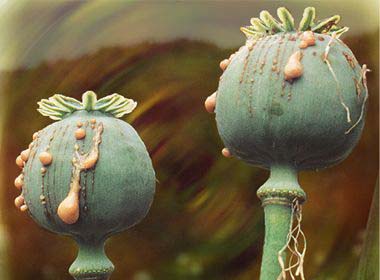 It's a great mystery really that despite the 114 hymns of the
Soma Pavamana there should be any doubt as to which plant was involved, in terms of
colour the drops of soma are always described as tawny brown to reddish, were the finished drink after the extract has been forced through the fleece
of a sheep and heated with milk is described as a golden green in colour
It's a great mystery really that despite the 114 hymns of the
Soma Pavamana there should be any doubt as to which plant was involved, in terms of
colour the drops of soma are always described as tawny brown to reddish, were the finished drink after the extract has been forced through the fleece
of a sheep and heated with milk is described as a golden green in colour
To Indra have the Soma drops, exceeding rich in sweets, been poured, Shed in the seat of sacrifice.
The pressers from the Soma-press send forth thy juice for rapturous joy the speckled sap runs like a flood.
The drops of Soma juice effused fall like the rain upon the earth: To Indra flow the Soma-streams.
Not surprisingly there was also considered a sacrificial quality to the flowing of the tawny drops;
And the tawny drops were considered to have the vitality of a steed;
It was also the case that Soma was drunk through a stalk/straw, as was the Mesopotamian drinking habit;
As i pointed out it was always hoped that the Soma would bring worldly wealth as well as qualities of insight and intelligence;
In the Vedic tradition though there are a couple of aspects lacking that were important in the Mesopotamian and Indus valley traditions, the association of the sages with the fish people and the importance of the spider, perhaps these do not directly relate to the hymns of production but though the relationship of the fish to the seven streams of Soma could be easily made it isn't, and in the Mesopotamian tradition the spider related to the cosmological network of Canis Major and was the key motif of those who traded in the sacred drink.
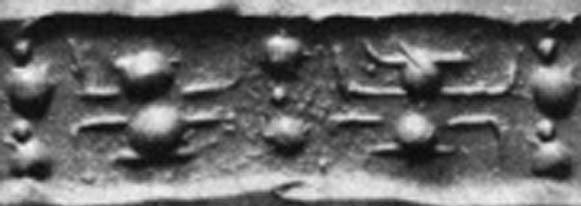
The spider was seen in conjunction with the pouring jar and cup were they are also a stylized symbol of the seated woman, the spider also related as Uttu to the eight body parts of Enki and also eight Deities including the Lords of Magan and Dilmun, suggesting that the motif could have represented different trading regions and families, that the spider was the symbol of the greater production network, extending into the Cosmos.

Maybe a case could be made then that the Vedic tradition arriving seemingly from Sintasha culture and adopting aspects of Indus valley culture were something of outsiders to earlier traditions that the Sumerians considered pre-Diluvian in origin, that they had taken control of the growing regions in Afghanistan and Northern India, it is difficult to say, but they did adopt the aspect that this was family tradition passed down through descent.
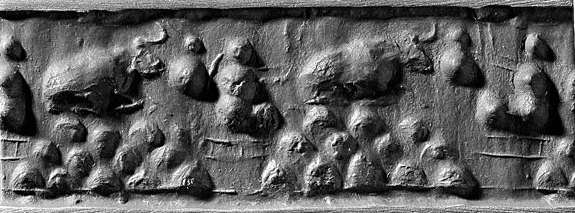
But anyway there we are, a tale from the distant past of when opium was the religion of the masses...
Soma thou flowest chasing foes and bringing wisdom and delight: Drive off the folk who love not Gods.
]
 It's a great mystery really that despite the 114 hymns of the
Soma Pavamana there should be any doubt as to which plant was involved, in terms of
colour the drops of soma are always described as tawny brown to reddish, were the finished drink after the extract has been forced through the fleece
of a sheep and heated with milk is described as a golden green in colour
It's a great mystery really that despite the 114 hymns of the
Soma Pavamana there should be any doubt as to which plant was involved, in terms of
colour the drops of soma are always described as tawny brown to reddish, were the finished drink after the extract has been forced through the fleece
of a sheep and heated with milk is described as a golden green in colour To Indra have the Soma drops, exceeding rich in sweets, been poured, Shed in the seat of sacrifice.
The pressers from the Soma-press send forth thy juice for rapturous joy the speckled sap runs like a flood.
The drops of Soma juice effused fall like the rain upon the earth: To Indra flow the Soma-streams.
Not surprisingly there was also considered a sacrificial quality to the flowing of the tawny drops;
By means of this eternal fleece may Sūrya's Daughter purify Thy Soma that is foaming forth. Ten sister maids of slender form seize him within the press and hold Him firmly on the final day.
After the 'way of ancient time, this God, pressed out for Deities, flows tawny to the straining-cloth. this Lord of many Holy Laws, even at his birth engendering strength,effused, flows onward in a stream.
And the tawny drops were considered to have the vitality of a steed;
Pavamana shall Bring treasures to the worshipper. Pour thou upon us thousandfold possessions, both of kine and steeds, Exceeding glorious, much-desired. By the Seven Ṛṣis’ holy songs. Drive ye that Tawny Courser, O ye pressers, on his way to war, Swift Steed who carries off the spoil.
It was also the case that Soma was drunk through a stalk/straw, as was the Mesopotamian drinking habit;
Together with the Ṛṣis, with their prayers and hymns ten women deck thee, Soma, friendly when effused. Pour out upon us wealth in goods, in gold, in steeds, in cattle and in corn, and great heroic strength. Sages well-skilled in work, intelligent, drain out the stalk that roars, the Sage, the Everlasting One.
As i pointed out it was always hoped that the Soma would bring worldly wealth as well as qualities of insight and intelligence;
Excellent Pavamana, make the lights shine brightly out for us. Speed us to mental power and skill. He, beautified by pious men, and coming from their hands adorned, flows through the fleecy straining-cloth. May Soma pour all treasures of the heavens, the earth, the firmament Upon the liberal worshipper.
In the Vedic tradition though there are a couple of aspects lacking that were important in the Mesopotamian and Indus valley traditions, the association of the sages with the fish people and the importance of the spider, perhaps these do not directly relate to the hymns of production but though the relationship of the fish to the seven streams of Soma could be easily made it isn't, and in the Mesopotamian tradition the spider related to the cosmological network of Canis Major and was the key motif of those who traded in the sacred drink.

The spider was seen in conjunction with the pouring jar and cup were they are also a stylized symbol of the seated woman, the spider also related as Uttu to the eight body parts of Enki and also eight Deities including the Lords of Magan and Dilmun, suggesting that the motif could have represented different trading regions and families, that the spider was the symbol of the greater production network, extending into the Cosmos.

Maybe a case could be made then that the Vedic tradition arriving seemingly from Sintasha culture and adopting aspects of Indus valley culture were something of outsiders to earlier traditions that the Sumerians considered pre-Diluvian in origin, that they had taken control of the growing regions in Afghanistan and Northern India, it is difficult to say, but they did adopt the aspect that this was family tradition passed down through descent.
According to the Brihadaranyaka Upanisad Gautama and Bharadvāja, Viśvāmitra and Jamadagni, Vashishtha and Kaśhyapa and Shandilya are seven sages (also known as Saptarishi); the progeny of these seven sages is declared to be gotras. This enumeration of seven primary gotras seems to have been known to Pāṇini. The offspring (apatya) of these seven are gotras and others than these are called gotrâvayava
There exists another theory about gotra: sons and disciples of a sage would have the same gotra; it is believed that they possess similar thought and philosophy. People of the same gotra can be found across different castes.

But anyway there we are, a tale from the distant past of when opium was the religion of the masses...
Soma thou flowest chasing foes and bringing wisdom and delight: Drive off the folk who love not Gods.
]
edit on Kam930249vAmerica/ChicagoTuesday0630 by Kantzveldt because: (no reason given)
Star and flag for the effort and presentation.. Thanks for adding decent content..
I watched a newearth vid that spent some time on Mohenjo-daro . The unusual part is that the first site had central planning .Could it have been a
time when it was decided to start making cities . If there is a portal to the unseen realm through drugs then they ( the gods ) may have used it to
communicate and steer mankind . Great post OP . I like the way you go into your threads and find some of the cross links to other cultures .
ETA this vid which gives some early understanding of religion and how the cultures at the time though and acted on it
.
edit on 6-9-2016 by the2ofusr1 because: (no reason given)
a reply to: the2ofusr1
It does sort of seem counter intuitive that a culture that had narcotics at it's core should go about civilization in such a well organized manner and establish far reaching trade networks, but i certainly think a major aspect of their ethos was living the good life and so perhaps that was the means toward that end, the Great Bath of Mohenjo Daro is a case in point, something i looked at here, also of course the sacred brew would have been a great way of attracting people to your civilization and keeping them there.
The cult of the fish people provides the only basis for any outside intelligent involvement in the establishment of civilization, if that was the case then it was based upon cultivation and production of opiates.
It does sort of seem counter intuitive that a culture that had narcotics at it's core should go about civilization in such a well organized manner and establish far reaching trade networks, but i certainly think a major aspect of their ethos was living the good life and so perhaps that was the means toward that end, the Great Bath of Mohenjo Daro is a case in point, something i looked at here, also of course the sacred brew would have been a great way of attracting people to your civilization and keeping them there.
The cult of the fish people provides the only basis for any outside intelligent involvement in the establishment of civilization, if that was the case then it was based upon cultivation and production of opiates.
a reply to: Kantzveldt
I admit to being totally ignorant of ancient cultures in any classical way. When I do attempt to approach such material, I find, as a simple-minded, degreed wordsmith, that I'm taken aback by the amount of emphasis and embellishment that writers of such materials can put into a simple element. Granted that figure can represent hundreds and even thousands of words if the element is explained in the context of it original setting, but I come away with the idea that modern interpreters want to write poetry more than history.
I admit to being totally ignorant of ancient cultures in any classical way. When I do attempt to approach such material, I find, as a simple-minded, degreed wordsmith, that I'm taken aback by the amount of emphasis and embellishment that writers of such materials can put into a simple element. Granted that figure can represent hundreds and even thousands of words if the element is explained in the context of it original setting, but I come away with the idea that modern interpreters want to write poetry more than history.
a reply to: Kantzveldt
If the ancients seen the heavens as waters above and wanted to show that then seeing that picture or expressed that way from the Genesis 6 account would make sense . One of the sins of the watchers was about teaching the cutting of roots and so this links the story for me .
If the ancients seen the heavens as waters above and wanted to show that then seeing that picture or expressed that way from the Genesis 6 account would make sense . One of the sins of the watchers was about teaching the cutting of roots and so this links the story for me .
a reply to: Kantzveldt
I can recall reading the correspondence between Robert Graves and R Gordon Wasson in the book 'Between Moon and Moon' and they were following the idea that Soma was in fact a mushroom. Graves even suggesting that this might be why the cow is revered in India as the now extinct fungi grew on the cow pats.
I just thought I'd throw that in and ask if you have considered the use of mushrooms as another source for Soma.
S+F
I can recall reading the correspondence between Robert Graves and R Gordon Wasson in the book 'Between Moon and Moon' and they were following the idea that Soma was in fact a mushroom. Graves even suggesting that this might be why the cow is revered in India as the now extinct fungi grew on the cow pats.
I just thought I'd throw that in and ask if you have considered the use of mushrooms as another source for Soma.
S+F
a reply to: midicon
The relationship of the bull and cows to the Soma was that it was effused in milk, there were probably also sexual connotations to the streams of Soma as related to the bull, Soma being seen as the essence of life, have a read of the 114 hymns related to it's production and you won't find any mention of mushrooms or dung.
a reply to: Aliensun
Well yes i suppose, from my perspective i generally am trying to identify the elements of the iconography and symbolism in the artwork and then relate what i see to what was written and what is known.
a reply to: the2ofusr1
They were accused of teaching all manner of wondrous things, but not to the Hebrews which is likely their problem...
The relationship of the bull and cows to the Soma was that it was effused in milk, there were probably also sexual connotations to the streams of Soma as related to the bull, Soma being seen as the essence of life, have a read of the 114 hymns related to it's production and you won't find any mention of mushrooms or dung.
a reply to: Aliensun
Well yes i suppose, from my perspective i generally am trying to identify the elements of the iconography and symbolism in the artwork and then relate what i see to what was written and what is known.
a reply to: the2ofusr1
They were accused of teaching all manner of wondrous things, but not to the Hebrews which is likely their problem...
edit on
Kam930249vAmerica/ChicagoTuesday0630 by Kantzveldt because: (no reason given)
a reply to: Kantzveldt
But the bible shows that the Hebrews were a after thought and they were not a people prior to Abram .
They were accused of teaching all manner of wondrous things, but not to the Hebrews which is likely their problem...
a reply to: the2ofusr1
Yummy, more food for thought to digest
revealed knowledge through chemically induced transference from the gods, shades of Castaneda and Terrence Mckenna
Yummy, more food for thought to digest
revealed knowledge through chemically induced transference from the gods, shades of Castaneda and Terrence Mckenna
originally posted by: Kantzveldt
For a second part having looked here at the cosmological significance i'll look at the textual evidence of Soma production to help clarify that it was indeed Opiate based, as the current consensus considers Cannabis...
One of my favorite historians and archaeologists Michael Wood did studies specifically on soma production. They tested several vessels believed to have contained soma using spectral analysis (or something beyond my comprehension) and found that at best, they contained only trace amounts of cannabis and many had none at all. The active ingredient was without a doubt ephedra - likely of poppy origin, as you implied.
The Rig Veda mentioned that Soma was a small, bitter root growing northwest of India beyond the Khyber Pass (apologies but I do not recall the specific scripture) and that it was a flowerless ground plant. The bitter aspect is important as it had to be sweetened with honey, supported by aforementioned testing.
If you are suggesting that the early cultures and civilizations achieved provenance through drug running then madame, I bite my thumb at you! Such distasteful actions are reserved for the Queen of England!
It would be fascinating to find out that Soma-dealers were the first international drug cartel. I can't help but recall tales such as Odin drinking from the well of wisdom in viking culture, and also how the Roman god Bacchus was associated with the sacred bull. Perhaps they dealt far.
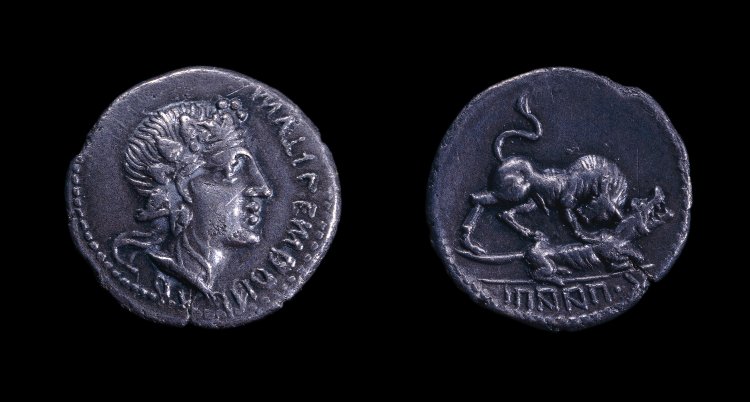
Coin from the Roman Social War depicting Bacchus on one side and a bull defeating a wolf on reverse. British Museum
edit on 6-9-2016 by SargonThrall because: (no reason given)
a reply to: SargonThrall
I think those suppositions relate more to Haoma from the Avesta rather than Soma, even though originally they were the same, there is reference on the Wiki page to twigs and stalks, which i suggested were actually for the drinking through, i just read through all the Rig Veda hymns and they don't indicate roots and honey.
The Jemdet Nasr seals do indicate large scale production in terms of the pouring jar and two cups motif and one also has to take into account the numerous references in the Rig Veda to the accumulation of wealth through the production of Soma, so i do think the Sage families were something similar to cartels, but with good intent...

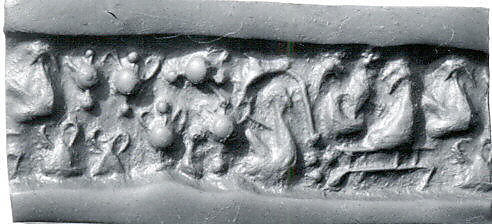
a reply to: the2ofusr1
That's true, more a sleight against their ancestors.
I think those suppositions relate more to Haoma from the Avesta rather than Soma, even though originally they were the same, there is reference on the Wiki page to twigs and stalks, which i suggested were actually for the drinking through, i just read through all the Rig Veda hymns and they don't indicate roots and honey.
The Jemdet Nasr seals do indicate large scale production in terms of the pouring jar and two cups motif and one also has to take into account the numerous references in the Rig Veda to the accumulation of wealth through the production of Soma, so i do think the Sage families were something similar to cartels, but with good intent...


a reply to: the2ofusr1
That's true, more a sleight against their ancestors.
edit on Kpm930249vAmerica/ChicagoTuesday0630 by Kantzveldt because: (no reason
given)
a reply to: Kantzveldt
Quite possible, though I am unaware of any difference between the two.
Perhaps you have missed verses or simply have a different translation, but honey is mentioned with Soma many times. For example, 10.123.3:
and 4.27.5
"Root" may be a mistake of my memory, but that is what I recall Wood saying. The hymns usually say that stalks are crushed by stones, but even that is strange as I thought that the hallucinogenic power was in the poppy head. Hymn 9.74.9 states that Soma must be passed through a wool sieve, implying that it is like an alcoholic mash, or lysergic acid. 9.74.2 says that Soma is mixed with milk, implying that it cannot be taken alone (diluted?). It may well have been an alcoholic drink mixed with ephedra, as it is called "fiery juice" (Agni-Somau). Perhaps we will never know for certain.
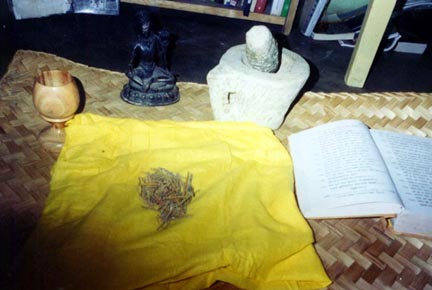
Indeed wealth is noted as the overarching desire of all mankind, as in 9.112.3 it says "with diverse thoughts we all strive for wealth, going after it like cattle".
As for "good intent", well... I imagine they saw addiction to a sacred substance as a positive thing. And all the better when one profits from it!
Quite possible, though I am unaware of any difference between the two.
Perhaps you have missed verses or simply have a different translation, but honey is mentioned with Soma many times. For example, 10.123.3:
The calf's many mothers from the same nest stand lowing at their common child. Striding to the crest of Order, the voices lick the honeyed drink of immortality.
and 4.27.5
The white goblet overflowing with cows' milk, the finest honey, the clear juice offered by the priests
"Root" may be a mistake of my memory, but that is what I recall Wood saying. The hymns usually say that stalks are crushed by stones, but even that is strange as I thought that the hallucinogenic power was in the poppy head. Hymn 9.74.9 states that Soma must be passed through a wool sieve, implying that it is like an alcoholic mash, or lysergic acid. 9.74.2 says that Soma is mixed with milk, implying that it cannot be taken alone (diluted?). It may well have been an alcoholic drink mixed with ephedra, as it is called "fiery juice" (Agni-Somau). Perhaps we will never know for certain.

Indeed wealth is noted as the overarching desire of all mankind, as in 9.112.3 it says "with diverse thoughts we all strive for wealth, going after it like cattle".
As for "good intent", well... I imagine they saw addiction to a sacred substance as a positive thing. And all the better when one profits from it!
a reply to: SargonThrall
That's true but it depends if the term honeyed is in order to imply sweet with regards to the milk, a poetic metaphor, but anyway it could only be something of a finishing touch according to taste, the effusion being with milk.
It is the case that opiates are soluble in water and can be extracted thus, so i have considered that a mash was made with other sacred plants and then that strained through the fleece, the myth of the spider Goddess Uttu who is represented on the seals involves eight such plants from Enki and Ninhursag.
There's plenty of evidence for the continuation of that through the mystery cults involving arrangements of eight bowled cups that held token plants
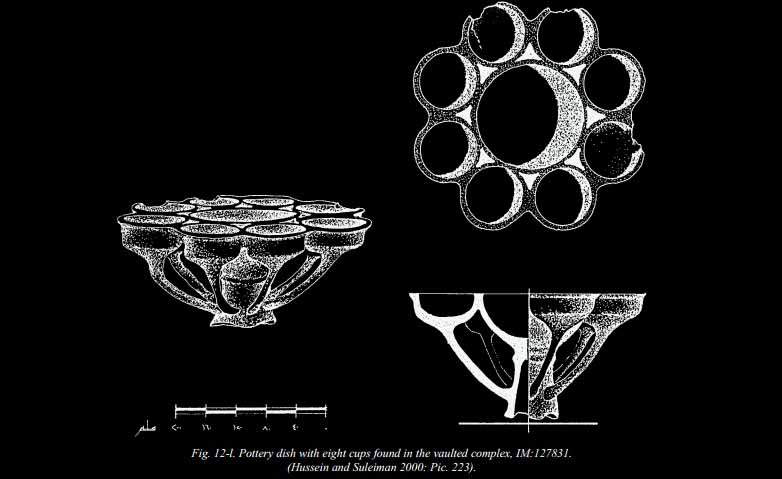
The intriguing question for me is whether you could commence the ordering of a civilization without such an incentive, there has to be something that binds people together to an entirely new way of life, and as far as morality goes at least they received an actual product and experience rather than simply the idea of the thing...also they did seem concerned with producing a safe product.

That's true but it depends if the term honeyed is in order to imply sweet with regards to the milk, a poetic metaphor, but anyway it could only be something of a finishing touch according to taste, the effusion being with milk.
It is the case that opiates are soluble in water and can be extracted thus, so i have considered that a mash was made with other sacred plants and then that strained through the fleece, the myth of the spider Goddess Uttu who is represented on the seals involves eight such plants from Enki and Ninhursag.
She grew the 'tree' plant, she grew the 'honey' plant, she grew the 'vegetable' plant, she grew the esparto grass (?), she grew the atutu plant, she grew the aštaltal plant, she grew the …… plant, she grew the amḫaru plant. "My master, the atutu plant," he said to him, cut it off for him and Enki ate it. "My master, the aštaltal plant," he said to him, pulled it up for him and Enki ate it. "My master, the …… plant," he said to him, cut it off for him and Enki ate it. "My master, the amḫaru plant," he said to him, pulled it up for him and Enki ate it. Enki determined the destiny of the plants, had them know it in their hearts.
There's plenty of evidence for the continuation of that through the mystery cults involving arrangements of eight bowled cups that held token plants

The intriguing question for me is whether you could commence the ordering of a civilization without such an incentive, there has to be something that binds people together to an entirely new way of life, and as far as morality goes at least they received an actual product and experience rather than simply the idea of the thing...also they did seem concerned with producing a safe product.

edit on Kam930250vAmerica/ChicagoWednesday0730 by Kantzveldt because: (no reason given)
Soma is delivered to the gods who live on mt meru by the garuda bird. The knowledge of what soma is was never given to the uninitiated and in time its
knowledge was lost or that is part of the mystery teaching, something that was lost and must be found. The priests apologize for forgetting the true
soma but it must be substituted by a herb which is golden/red in colour (the colour of the Sun at sunrise).
a reply to: Kantzveldt
Is there any sort of scholarly support for this? I know that Huxley and a few others got into the "soma" idea, but you seem to be mixing Indus Valley civilization with Sumeria and the two are as different as the Celts and the Japanese. In addition, am I thinking correctly that the Indus Valley inscriptions aren't translated?
To say that one object has the same meaning or a similar meaning in two different cultures or even in the same culture in two different time periods is a step in the wrong direction, IMHO. The Jackal is seen as cowardly and unclean in the Arabian peninsula, but was worshiped as a god and a guardian in Egypt next door (as one example that overgeneralizes cultures and scrambles time.) Set, the Egyptian god of the desert, was seen as a fierce warrior during certain centuries and negative force and enemy during other centuries.
Do you have any scholarly papers that support the interpretations?
Yeah, I know I'm picky. The topic is interesting and I want to know more but I'm not satisfied with guesses.
Is there any sort of scholarly support for this? I know that Huxley and a few others got into the "soma" idea, but you seem to be mixing Indus Valley civilization with Sumeria and the two are as different as the Celts and the Japanese. In addition, am I thinking correctly that the Indus Valley inscriptions aren't translated?
To say that one object has the same meaning or a similar meaning in two different cultures or even in the same culture in two different time periods is a step in the wrong direction, IMHO. The Jackal is seen as cowardly and unclean in the Arabian peninsula, but was worshiped as a god and a guardian in Egypt next door (as one example that overgeneralizes cultures and scrambles time.) Set, the Egyptian god of the desert, was seen as a fierce warrior during certain centuries and negative force and enemy during other centuries.
Do you have any scholarly papers that support the interpretations?
Yeah, I know I'm picky. The topic is interesting and I want to know more but I'm not satisfied with guesses.
Where is the secret shrine of heaven, where are those waters young and fresh. Flow, Indu, flow for Indra's sake. Make me immortal in that realm where they move even as they list, In the third sphere of inmost heaven where lucid worlds are full of light. Flow, Indu, flow for Indra's sake.
there are a few sacred substances
and they all get jumbled up
ambrosiasociety.org...
en.wikipedia.org...
By means of this eternal fleece may Sūrya's Daughter purify Thy Soma
Great thread
edit on 17-9-2016 by kibric because: Arutperumjothi
a reply to: Byrd
Technically the Mesopotamian seals are all Jemdet Nasr period that predates the Sumerian Dynastic, of seals found relating to that period i would say around 60% relate to the subject matter involved here, seated woman with pony tail/jar and two cups/association with bull and spider motif, they're also found very widely distributed centred upon Uruk through. Iran, Bahrain and the head of the gulf, suggesting this related to an important and widely traded commodity of that period.
There's extensive evidence for trade contact with Mesopotamia and the Indus valley and the evidence for Indus valley/Meluhhan communities in Southern Mesopotamia at the trading port of Nigin, were there also seems to be influence with regards to the local Pantheon.
An Indus valley community within Sumeria
I would also suggest that the fish people cult of Nigin had correspondence in Indus valley culture, also of course there are informed considerations as to the individual signs of Indus valley script;
The Fish that swam in the Great Bath
I would then consider the Jemdet Nasr seals and those of the Indus valley as very closely related at an early date, it's something of a mystery that all those seal types disappear into the Dynastic period.
Technically the Mesopotamian seals are all Jemdet Nasr period that predates the Sumerian Dynastic, of seals found relating to that period i would say around 60% relate to the subject matter involved here, seated woman with pony tail/jar and two cups/association with bull and spider motif, they're also found very widely distributed centred upon Uruk through. Iran, Bahrain and the head of the gulf, suggesting this related to an important and widely traded commodity of that period.
There's extensive evidence for trade contact with Mesopotamia and the Indus valley and the evidence for Indus valley/Meluhhan communities in Southern Mesopotamia at the trading port of Nigin, were there also seems to be influence with regards to the local Pantheon.
An Indus valley community within Sumeria
I would also suggest that the fish people cult of Nigin had correspondence in Indus valley culture, also of course there are informed considerations as to the individual signs of Indus valley script;
The Fish that swam in the Great Bath
I would then consider the Jemdet Nasr seals and those of the Indus valley as very closely related at an early date, it's something of a mystery that all those seal types disappear into the Dynastic period.
new topics
-
Advice for any young Adult .
General Chit Chat: 55 minutes ago -
Joe meant what he said about Hunter's pardon....
US Political Madness: 1 hours ago -
Regent Street in #London has been evacuated due to a “bomb threat.”
Other Current Events: 2 hours ago -
It’s Falling…
Philosophy and Metaphysics: 3 hours ago -
Steering the Titantic from the Drydock.
Rant: 7 hours ago
top topics
-
Steering the Titantic from the Drydock.
Rant: 7 hours ago, 10 flags -
Joe meant what he said about Hunter's pardon....
US Political Madness: 1 hours ago, 9 flags -
Hearing more ambulances lately
Medical Issues & Conspiracies: 17 hours ago, 8 flags -
Los Angeles brush fires latest: 2 blazes threaten structures, prompt evacuations
Mainstream News: 17 hours ago, 7 flags -
Paramilitary Leaks - John Williams
Whistle Blowers and Leaked Documents: 16 hours ago, 7 flags -
Advice for any young Adult .
General Chit Chat: 55 minutes ago, 5 flags -
It’s Falling…
Philosophy and Metaphysics: 3 hours ago, 4 flags -
Some sausage, some chicken, some sauce, some onions and some garlic...and some peppers!
Food and Cooking: 17 hours ago, 3 flags -
Regent Street in #London has been evacuated due to a “bomb threat.”
Other Current Events: 2 hours ago, 3 flags
active topics
-
Labour Plotting to Postpone May's Council Elections ?
Regional Politics • 18 • : gortex -
Advice for any young Adult .
General Chit Chat • 5 • : underpass61 -
Paramilitary Leaks - John Williams
Whistle Blowers and Leaked Documents • 9 • : charlyv -
Steering the Titantic from the Drydock.
Rant • 33 • : ufoorbhunter -
Regent Street in #London has been evacuated due to a “bomb threat.”
Other Current Events • 5 • : Oldcarpy2 -
Greatest thing you ever got, or bought?
General Chit Chat • 28 • : Flyingclaydisk -
Joe meant what he said about Hunter's pardon....
US Political Madness • 8 • : BeyondKnowledge3 -
Los Angeles brush fires latest: 2 blazes threaten structures, prompt evacuations
Mainstream News • 20 • : BeyondKnowledge3 -
Russia Ukraine Update Thread - part 3
World War Three • 6902 • : Oldcarpy2 -
It’s Falling…
Philosophy and Metaphysics • 2 • : JJproductions
